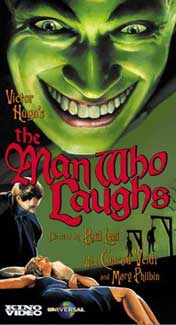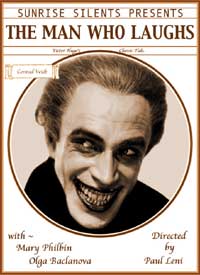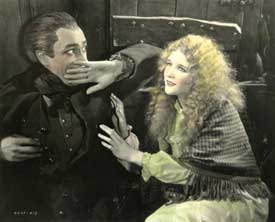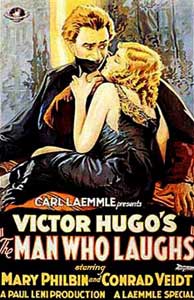 A monumental epic based on a novel by Victor Hugo, The Man Who Laughs (1928) is one of the magnificent achievements of silent cinema. A monumental epic based on a novel by Victor Hugo, The Man Who Laughs (1928) is one of the magnificent achievements of silent cinema.
Three years in the making, the silent era was ringing out by the time it was finished, & a last-minute synchronized soundtrack of startling effectiveness was created for the film, making this a true bridge between the silent & sound eras, though it remains in the main a silent classic.
Inspired by & much in the manner of Lon Chaney's Hunchback of Notre Dame (1923) & The Phantom of the Opera (1925), it was originally conceived as another Chaney vehicle.
But with German director Paul Leni at the helm, & German star Conrad Veidt at the center of the tale, it's more purely German expressionist in the manner of Der Golem (1920) or The Cabinet of Dr. Caligari (1920) than like other American silent horror classics.
Gwynplaine when a child was hideously disfigured by gypsies, at the command of cruel King James II (Sam De Grasse), who was incited to anger over a lord's small slight. This resulted in the father consigned to the Iron Maiden, & his orphaned son given his eternal clown's smile or deathhead's grimace.
 As a child he's played by Julius Molner, Jr., & the beauty of his hideousness -- & the mere notion of an intentionally disfigured child -- provides one of the most disturbing images ever committed to horror cinema. The child's essential innocence is always evident, as he wanders an icy gothic landscape of ruins & hanged men. As a child he's played by Julius Molner, Jr., & the beauty of his hideousness -- & the mere notion of an intentionally disfigured child -- provides one of the most disturbing images ever committed to horror cinema. The child's essential innocence is always evident, as he wanders an icy gothic landscape of ruins & hanged men.
He's befriended & fostered by a strolling carnival performer, "Ursus the Philosopher" (Cesare Gravina). With Ursus & the heroic dog Homo the Wolf & the blind infant Dea, they are a real family. Gwynplaine grows up with the blind girl (Mary Philbin) who loves him without ever having judged him by his disfigurement.
A Duchess (Olga Baclanova) affects a perverse crush on Gwynplaine even before learning he is the rightful heir to the properties she has been using as her own for many years. Her scenes of eroticism exceed by far what would be allowed after the motion picture production code went into censorious effect.
An appalling jester, Barkilphedro (Brandon Hurst), knows the story of Gwynplaine from its root, & uses his knowledge to curry the queen's favors.
 When Queen Anne (Josephine Crowell) learns of Gwynplaine's identity, she would restore to him his birth-father's title & lands, meaning also a peership in the House of Lords. But he must marry the Duchess to insure her continued future as well, though he of course loves Dea. When Queen Anne (Josephine Crowell) learns of Gwynplaine's identity, she would restore to him his birth-father's title & lands, meaning also a peership in the House of Lords. But he must marry the Duchess to insure her continued future as well, though he of course loves Dea.
Being insufficiently bitter to realize he is only being used for others' ends, Gwynplaine dares believe life's injustices are being stripped away, & that peership & property will at least partially repair his life of sorrows.
But behind his back, Ursus who loved & fostered both Gwynplaine & Dea are banished from England, after they were first convinced of Gwynplaine's death.
Gwynplaine's despairing existence, due always to his appearance, is unabating throughout the tale, & only worsened by royal machinations. He is forever unable to convey his suffering through the perpetual & hideously gigantic grin. Veidt, restricted to acting with his hands & eyes, creates a heartbreaking portrait of a sublime soul.
He has remained largely passive while batted about by royals purporting to have his interests in mind, when he is only a pawn. But at last he erupts into heroic action, & the climax is one of extraordinary swashbuckling action as he protests the queen's commands & is pursued through London seeking Dea. More than a great film, The Man Who Laughs is a thorough work of art.
copyright © by Paghat the Ratgirl
|

